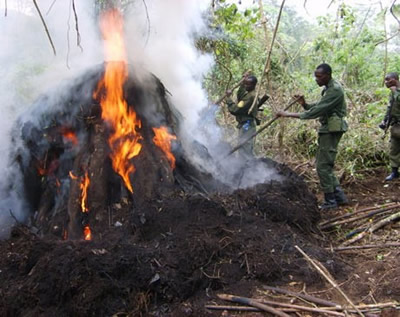Biochar's History as an Ancient Soil Amendment— Biochar is a form of charcoal produced from super-heating biomass. It is found naturally in soils around the world as a result of vegetation fires. Biochar has also been created and used by humans in traditional agricultural practices in the Amazon Basin of South America for more than 2,500 years. Dark, charcoal-rich soil (known as terra preta or black earth) supported productive farms in areas that previously had poor, and in some places, toxic soils.
Terra preta was discovered in the 1950's by Dutch soil scientist Wim Sombroek in the Amazon rainforest. Terra preta still covers 10% of the Amazon Basin. Similar sites have been found in Ecuador, Peru, Benin and Liberia in West Africa.
Typically, jungle soils are very unproductive. After mixing biochar into the topsoil, the soil was able to retain vital organic matter, plant nutrients and moisture essential for plant growth. This practice allowed annual cultivation of the same fields, rather than slash-and-burn practices necessary to eke out crops on new land every few years. Given a stable location for agriculture and soils made fertile by char, a steady food supply was possible. This allowed for the establishment of large communities.
However, making charcoal has not been an environmentally friendly practice.
 Traditional Production Techniques— The historic method of creating charcoal is to simply pile and cover wood , allowing it to burn slowly with limited air. This method, still used today in developing countries, creates considerable smoke and releases half the carbon dioxide (CO2) in the original biomass. Whereas charcoal is the result and can be put into soil, its production is not healthy for people or the atmosphere, and all that heat (energy) is wasted.
Traditional Production Techniques— The historic method of creating charcoal is to simply pile and cover wood , allowing it to burn slowly with limited air. This method, still used today in developing countries, creates considerable smoke and releases half the carbon dioxide (CO2) in the original biomass. Whereas charcoal is the result and can be put into soil, its production is not healthy for people or the atmosphere, and all that heat (energy) is wasted.
A New Approach—With Multiple Benefits— The principles of making biochar haven't changed over the centuries but the methods have. Today biochar can be produced in an environmentally friendly way - and it needs to be! Pyrolysis, burning with limited oxygen in a closed system, allows material to be burned at high temperatures and have all the emissions captured. That means the CO2 and other greenhouse gases are not released but re-burned in the system or broken down into less harmful elements.
In the search for solutions to climate change; growing energy demands; soil exhaustion (just when we need to feed more people); declining water quality; and excessive biomass waste this revolutionary substance called biochar has been rediscovered! But what's so exciting about biochar is our emerging understanding of what it can do for us and the planet beyond increasing the health and productivity of soil for crops and forests.
Biochar has the potential to:
- capture toxins and excess nitrogen protecting our waterways and groundwater quality,
- in making biochar, create an alternative energy source for generating heat and power, and valuable by-products of syngas and bio-fuels, thereby reducing CO2 emissions,
- reduce the need for (and use of) fossil-fuels and fossil-fuel based fertilizers,
- turn biomass and biowaste into value-added products while creating jobs, and
- safely sequester CO2 for thousands of years which slows climate change.
Scientists around the world are researching all aspects of biochar production and chemical compositions based on different feed stocks. With this new knowledge—and some indigenous wisdom—we are discovering that biochar has the potential to simultaneously address multiple environmental, social and technological time-bombs on a global scale.
Click here for a printer friendly version.
